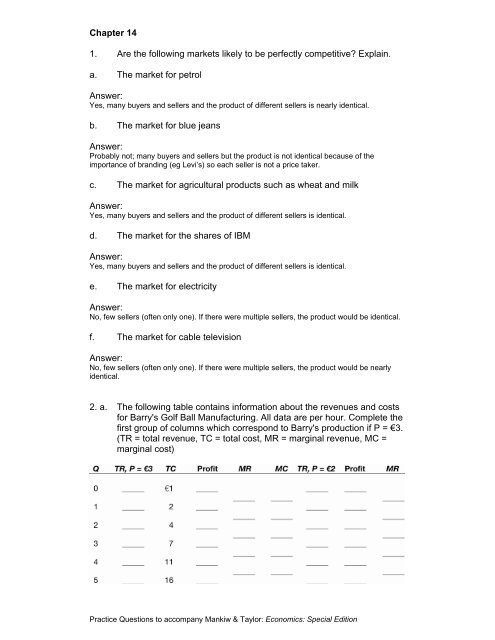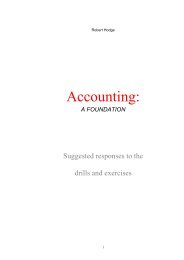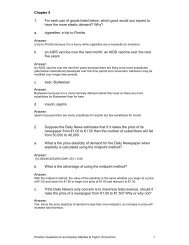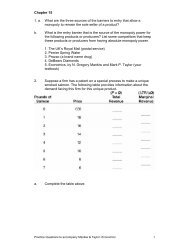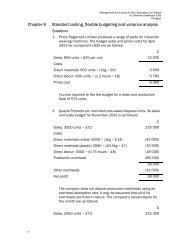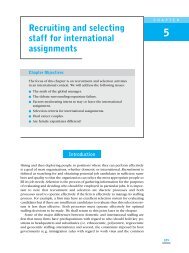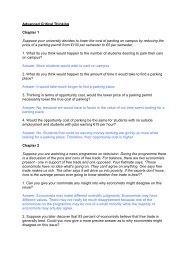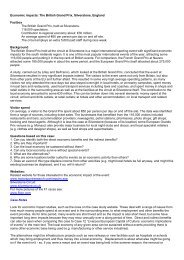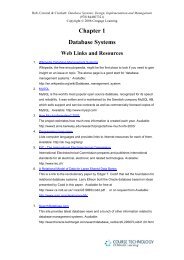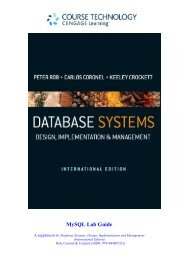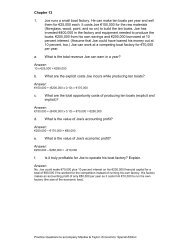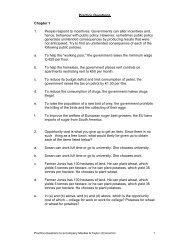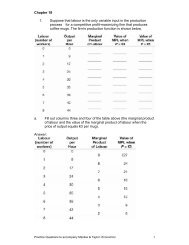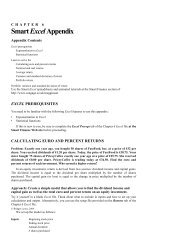Chapter 14 Questions and answers
Chapter 14 Questions and answers
Chapter 14 Questions and answers
- No tags were found...
Create successful ePaper yourself
Turn your PDF publications into a flip-book with our unique Google optimized e-Paper software.
<strong>Chapter</strong> <strong>14</strong>1. Are the following markets likely to be perfectly competitive? Explain.a. The market for petrolAnswer:Yes, many buyers <strong>and</strong> sellers <strong>and</strong> the product of different sellers is nearly identical.b. The market for blue jeansAnswer:Probably not; many buyers <strong>and</strong> sellers but the product is not identical because of theimportance of br<strong>and</strong>ing (eg Levi’s) so each seller is not a price taker.c. The market for agricultural products such as wheat <strong>and</strong> milkAnswer:Yes, many buyers <strong>and</strong> sellers <strong>and</strong> the product of different sellers is identical.d. The market for the shares of IBMAnswer:Yes, many buyers <strong>and</strong> sellers <strong>and</strong> the product of different sellers is identical.e. The market for electricityAnswer:No, few sellers (often only one). If there were multiple sellers, the product would be identical.f. The market for cable televisionAnswer:No, few sellers (often only one). If there were multiple sellers, the product would be nearlyidentical.2. a. The following table contains information about the revenues <strong>and</strong> costsfor Barry's Golf Ball Manufacturing. All data are per hour. Complete thefirst group of columns which correspond to Barry's production if P = €3.(TR = total revenue, TC = total cost, MR = marginal revenue, MC =marginal cost)Practice <strong>Questions</strong> to accompany Mankiw & Taylor: Economics: Special Edition
Answer:b. If the price is €3 per golf ball, what is Barry's optimal level ofproduction? What criteria did you use to determine the optimal level ofproduction?Answer:Optimal production is either two or three golf balls per hour. This level of productionmaximizes profit (at €2) <strong>and</strong> it is the level of output where MC = MR (at €3).c. Is €3 per golf ball a long-run equilibrium price in the market for golfballs? Explain. What adjustment will take place in the market for golfballs <strong>and</strong> what will happen to the price in the long run?Answer:No, because Barry is earning positive economic profits of €2. These profits will attract newfirms to enter the market for golf balls, the market supply will increase, <strong>and</strong> the price will falluntil economic profits are zero.d. Suppose the price of baseballs falls to €2. Fill out the remaining threecolumns of the table above. What is the profit-maximizing level ofoutput when the price is €2 per baseball? How much profit does Barry'sBaseball Manufacturing earn when the price of baseballs is €2?Answer:Optimal production is either one or two golf balls per hour. Zero economic profit is earned byBarry.Practice <strong>Questions</strong> to accompany Mankiw & Taylor: Economics: Special Edition
e. Is €2 per golf ball a long-run equilibrium price in the market for golfballs? Explain. Why would Barry continue to produce at this level ofprofit?Answer:Yes. Economic profits are zero <strong>and</strong> firms neither enter nor exit the industry. Zero economicprofits means that Barry doesn’t earn anything beyond his opportunity costs of production buthis revenues do cover the cost of his inputs <strong>and</strong> the value of his time <strong>and</strong> money.f. Describe the slope of the short-run supply curve for the market for golfballs. Describe the slope of the long-run supply curve in the market forgolf balls.Answer:The slope of the short-run supply curve is positive because when P = €2, quantity supplied isone or two units per firm <strong>and</strong> when P = €3, quantity supplied is two or three units per firm. Inthe long run, supply is horizontal (perfectly elastic) at P = €2 because any price above €2causes firms to enter <strong>and</strong> drives the price back to €2.3. a. In Exhibit 1, show the cost curves of a representative firm in long-runequilibrium along side the corresponding market equilibrium.Exhibit 1Answer:See Exhibit 5.Exhibit 5Practice <strong>Questions</strong> to accompany Mankiw & Taylor: Economics: Special Edition
. Suppose there is a decrease in the dem<strong>and</strong> for this product. In Exhibit2, show the shift in dem<strong>and</strong> in the market for this product <strong>and</strong> thecorresponding profit or loss on the cost curves of the representativefirm.Exhibit 2Answer:See Exhibit 6.Exhibit 6c. In Exhibit 3, show the adjustment that takes place in order to return themarket <strong>and</strong> firm to long-run equilibrium.Exhibit 3Practice <strong>Questions</strong> to accompany Mankiw & Taylor: Economics: Special Edition
Answer:See Exhibit 7.Exhibit 7d. After the market has returned to long-run equilibrium, is the pricehigher, lower, or the same as the initial price? Are there more, fewer, orthe same number of firms producing in the market?Answer:The price has returned to its initial level. There are fewer firms producing in this market.Practice <strong>Questions</strong> to accompany Mankiw & Taylor: Economics: Special Edition


